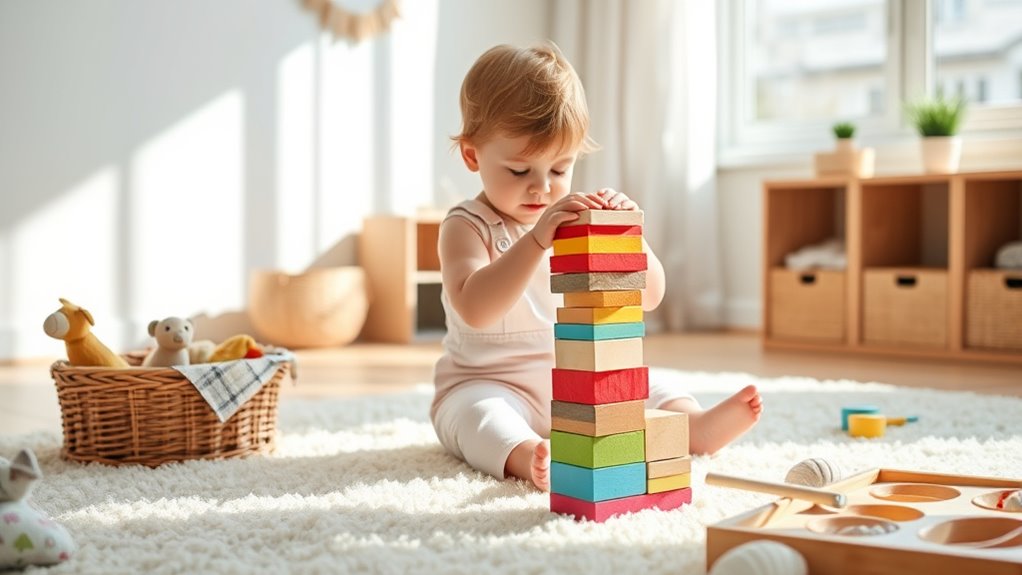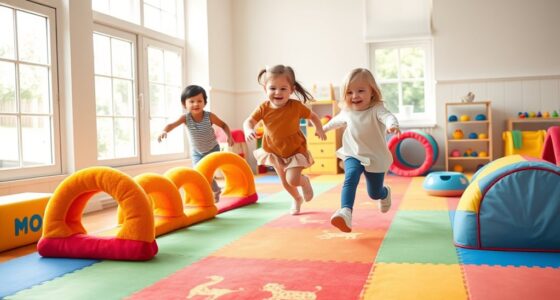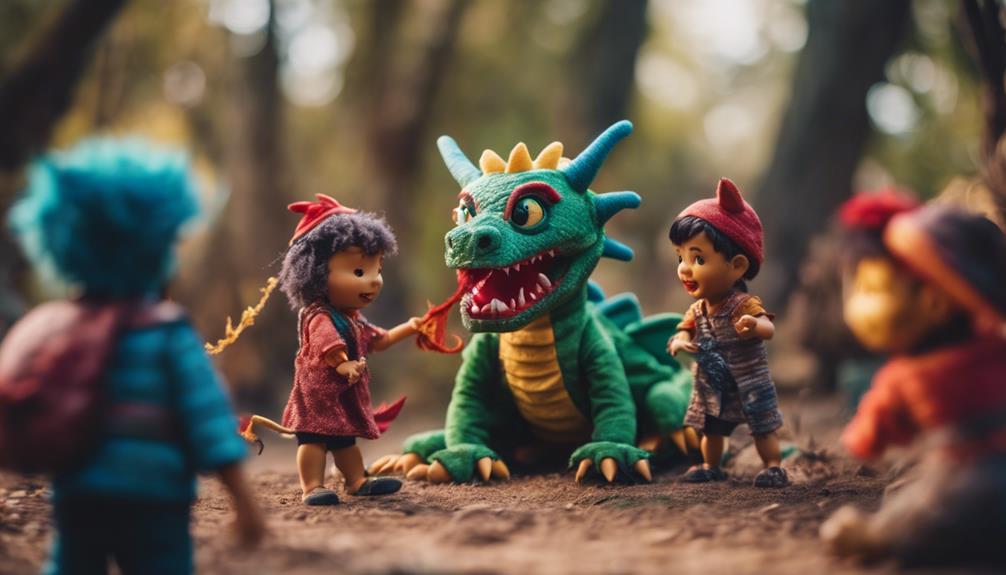To encourage toddler independence, create cozy spaces like a reading nook or sensory corner filled with familiar toys and soft lighting. Set up themed zones with open-ended toys, building blocks, and art supplies that are easy to access. Incorporate sensory bins with different textures, natural materials, and calming activities to spark curiosity. Keep everything organized and safe, so your little one can explore confidently. If you keep exploring, you’ll find more ideas to make solo play both fun and safe.
Key Takeaways
- Create designated cozy corners or themed play zones with accessible toys and materials to foster independent exploration.
- Use sensory bins with diverse textures and calming activities to engage tactile and sensory processing skills.
- Incorporate recyclable, natural, and safe art supplies for open-ended creative play and fine motor development.
- Set up classic toy stations with musical instruments, dress-up clothes, and role-play props to inspire imaginative solo adventures.
- Ensure safety by supervising play, avoiding small hazards, and providing stable, clean surfaces for activities like building and sensory bins.
Creating a Cozy Corner for Solo Play
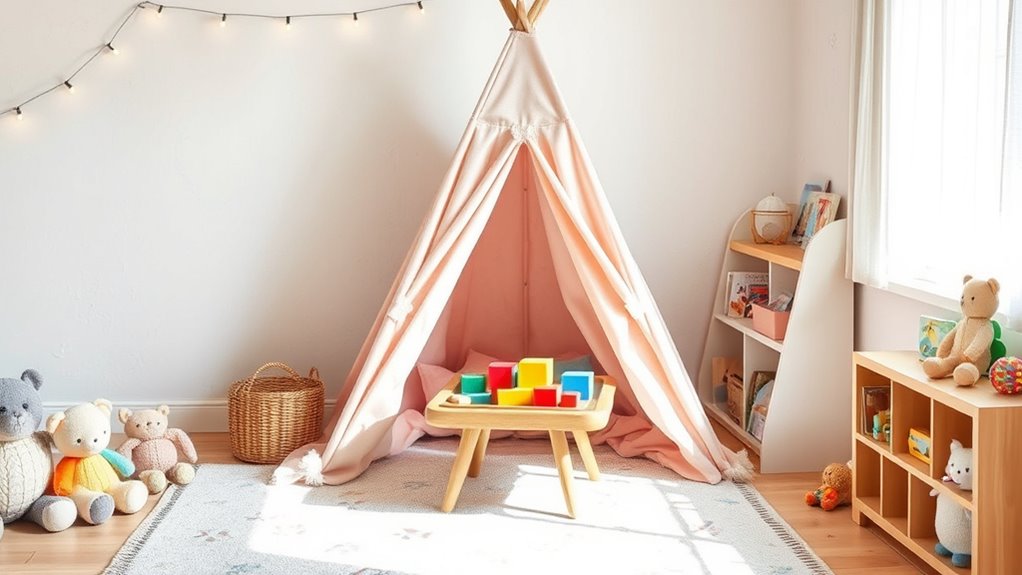
To encourage independent play, start by creating a cozy corner where your toddler feels safe and comfortable. Designate a soft blanket corner or a cozy reading nook filled with plush cushions and gentle lighting. Use familiar items like their favorite stuffed animals or books to make the space inviting. Keep the area clutter-free and accessible, so your child can easily choose activities and feel a sense of ownership. This cozy space encourages your toddler to explore on their own, fostering independence and confidence. Remember, the goal is to create a welcoming environment where they can play freely without feeling overwhelmed. Incorporating informal language in your communication can help you better understand your child’s needs and interests, making the space even more engaging. With a little effort, you’ll have a special spot that invites solo play and sparks your child’s imagination.
Classic Toy Stations for Independent Exploration

Setting up classic toy stations is an effective way to promote independent exploration in your toddler. Create a music station with simple instruments like shakers, drums, or tambourines to encourage rhythm and self-expression. Let your child experiment with different sounds and develop their auditory skills. Another station can feature dress-up clothes and accessories, inspiring imaginative play and storytelling. Provide a mirror nearby so they can see themselves as they role-play. These stations foster creativity, problem-solving, and confidence as your toddler independently explores and manipulates familiar toys. Keep the setup accessible and organized, allowing your child to choose activities freely. Incorporating play environments designed for independence can further enhance their confidence and self-directed learning. Creating a space for autonomous play supports children in developing decision-making skills and independence during their playtime. Additionally, arranging outdoor water play areas can introduce sensory experiences and encourage exploration in a natural setting. Utilizing textile art techniques such as fabric textures or simple stitched patterns can also provide tactile stimulation and promote fine motor development during independent play.
Sensory Bins to Stimulate Curiosity
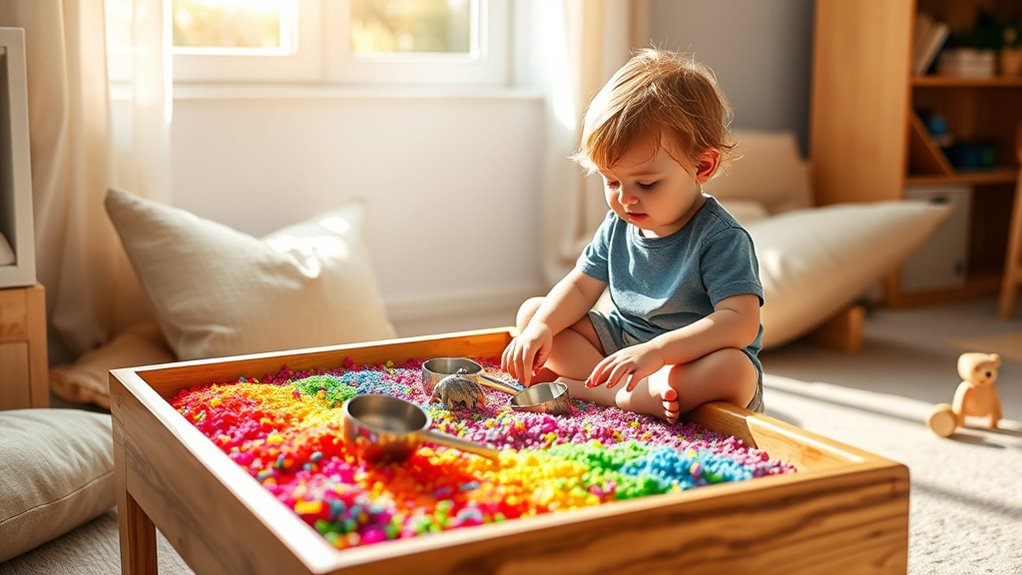
Sensory bins with different textures can spark your toddler’s curiosity and encourage exploration. Bright, colorful materials engage their senses and invite hands-on play. Be sure to follow safety tips to keep the experience safe and fun for your little one. Using self-watering plant pots as a sensory activity can also introduce your child to plant care in a safe and engaging way. Incorporating local resources and community tools can enhance the variety of sensory experiences available to your child. Recognizing the importance of father-daughter bonds can inspire caregivers to create nurturing environments that promote independence and confidence in their little ones. Including sensory processing skills in activities helps support healthy cognitive development and emotional regulation.
Interactive Textures Spark Interest
Interactive textures catch toddlers’ attention and encourage exploratory play, making sensory bins a valuable tool for their development. When you introduce different textures, you promote textural exploration, helping your toddler understand how various surfaces feel. These tactile experiences support sensory development and boost fine motor skills as they grasp, sift, and manipulate objects. By offering a variety of materials like soft fabrics, rough stones, or squishy gel, you create opportunities for tactile stimulation that keep your child engaged and curious. This hands-on approach builds their confidence in exploring new sensations independently, fostering a sense of discovery. Incorporating sensory development activities like sensory bins with diverse textures turns playtime into a rich, stimulating experience that cultivates curiosity and enhances their understanding of the world around them. Additionally, providing age-appropriate materials ensures safety while maximizing learning and enjoyment during independent play. Engaging with different textures can also contribute to skin health by gently exfoliating and nourishing the skin during tactile play.
Colorful Materials Engage Senses
Brightly colored materials instantly capture your toddler’s attention and invite them to explore with curiosity. Using colorful materials in sensory bins stimulates their engaging senses and encourages independent play. As your child reaches in, they’ll discover different textures, shapes, and colors, which enhances their sensory development. The vibrant hues naturally attract their gaze, prompting them to touch, scoop, and manipulate objects, fostering fine motor skills. These engaging senses help your toddler learn about the world around them and build their concentration. Keep the materials varied—like rice, pasta, or pom-poms—to maintain their interest and challenge their senses. Incorporating animated movies can also inspire imaginative play and emotional growth. By providing colorful, sensory-rich materials, you create a stimulating environment that encourages your toddler to explore confidently and enjoy solo playtime.
Safety Tips for Sensory Bins
While sensory bins are a wonderful way to stimulate your toddler’s curiosity, guaranteeing their safety is essential. Always supervise your child during play and choose non-toxic, washable materials. Before starting, teach hygiene practices like washing hands before and after exploration to prevent germs. Keep small items that pose choking hazards out of reach and inspect the contents regularly for broken pieces. Incorporate nutrition tips by including edible, safe materials like cooked pasta or fruit pieces, if appropriate. Guarantee the sensory bin is on a stable surface to prevent spills. After play, clean the bin thoroughly to maintain hygiene and prevent bacteria buildup. By combining safety measures with good hygiene practices, you create a safe, engaging environment for your toddler’s independent exploration.
Open-Ended Art and Craft Areas
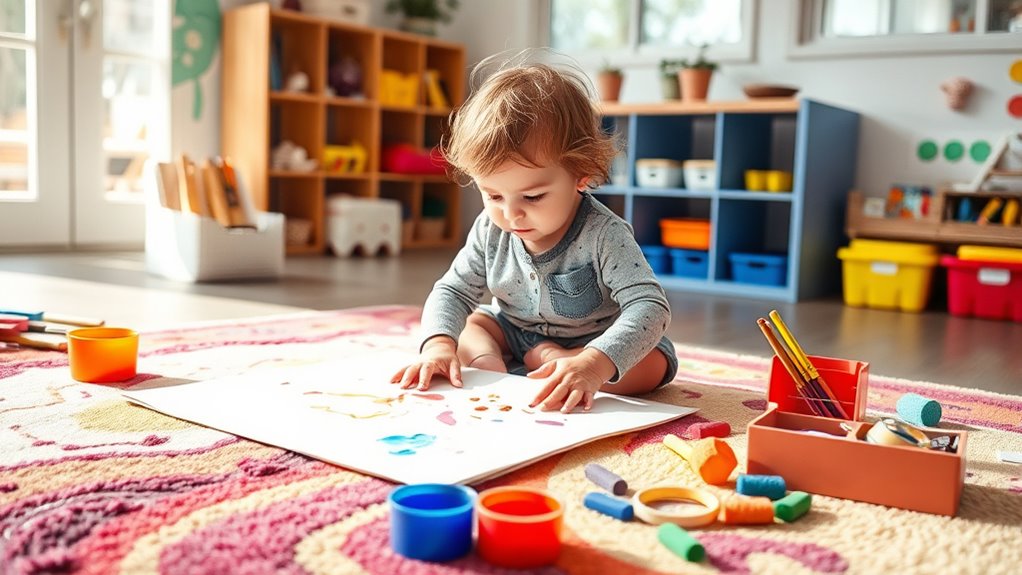
Creating an open-ended art and craft area with diverse materials encourages your toddler’s creativity. Use safe, easy-to-handle supplies that they can explore independently. This setup helps foster their confidence and imagination during playtime. Incorporating educational toys that promote skill development can further enrich their independent play experience. Additionally, selecting materials that are non-toxic and age-appropriate ensures a safe environment for your child’s artistic exploration. Choosing toys that align with Montessori philosophies can support your child’s development of practical life skills and independence.
Diverse Materials for Creativity
Offering a variety of materials in open-ended art and craft areas encourages toddlers to explore their creativity freely. Recyclable materials like cardboard, bottle caps, and scrap paper spark their imagination and teach sustainability. Natural elements such as sticks, leaves, and shells provide tactile experiences and inspiration from nature. These diverse materials allow toddlers to experiment without strict rules, fostering independence and problem-solving skills. By incorporating recyclable and natural items, you create an eco-friendly space that promotes environmental awareness from a young age. Toddlers can build, collage, or craft with these materials, developing fine motor skills and artistic confidence. Keep the area accessible and inviting, so they can choose what interests them and express themselves creatively at their own pace. Additionally, understanding foraging ranges can help caregivers select local natural elements safely and responsibly, ensuring a sustainable approach to collecting outdoor materials.
Safe, Easy-to-Use Supplies
Providing safe, easy-to-use supplies is essential for encouraging toddlers to explore art independently. Use age-appropriate toys and non-toxic supplies to guarantee safety and build confidence. Keep materials simple, like washable markers, crayons, and finger paints, which are easy for little hands to manage. Organize supplies in low, accessible containers so toddlers can choose what they want to use without assistance. Avoid small parts or anything that could pose a choking hazard. When you select non-toxic supplies, you give your child peace of mind while fostering creativity. Creating a safe environment is crucial for encouraging independent exploration. Ensuring that the environment supports child development helps toddlers gain confidence in their abilities and encourages sustained engagement. Incorporating Open-Ended Art and Craft Areas can stimulate creativity and allow children to express themselves freely during their independent play.
Building and Stacking Challenges
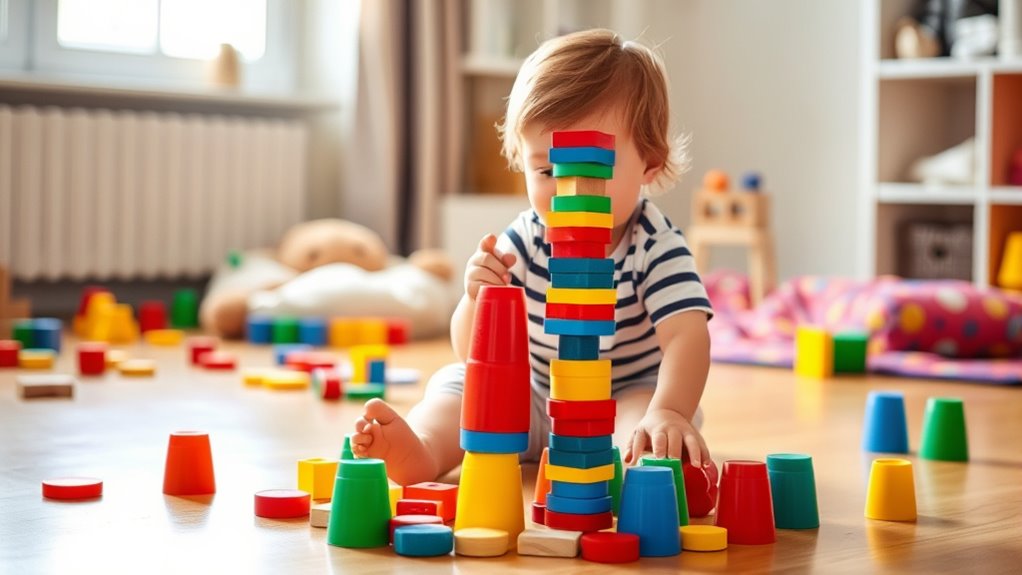
Building and stacking challenges are excellent ways to help toddlers develop their fine motor skills and spatial awareness. You can provide a set of building blocks or materials like wooden blocks and foam cubes to encourage this. Start with simple tasks, such as creating small stacking towers, to build their confidence. As they improve, challenge them to balance blocks higher or build more complex structures. These activities promote hand-eye coordination, problem-solving, and patience. Let your toddler experiment with different arrangements, guiding them gently when needed. Keep the challenges fun and achievable, celebrating their successes to boost motivation. By offering these opportunities, you foster independence and critical thinking in your child’s play, all while strengthening their foundational motor skills.
Themed Play Zones for Imaginative Adventures
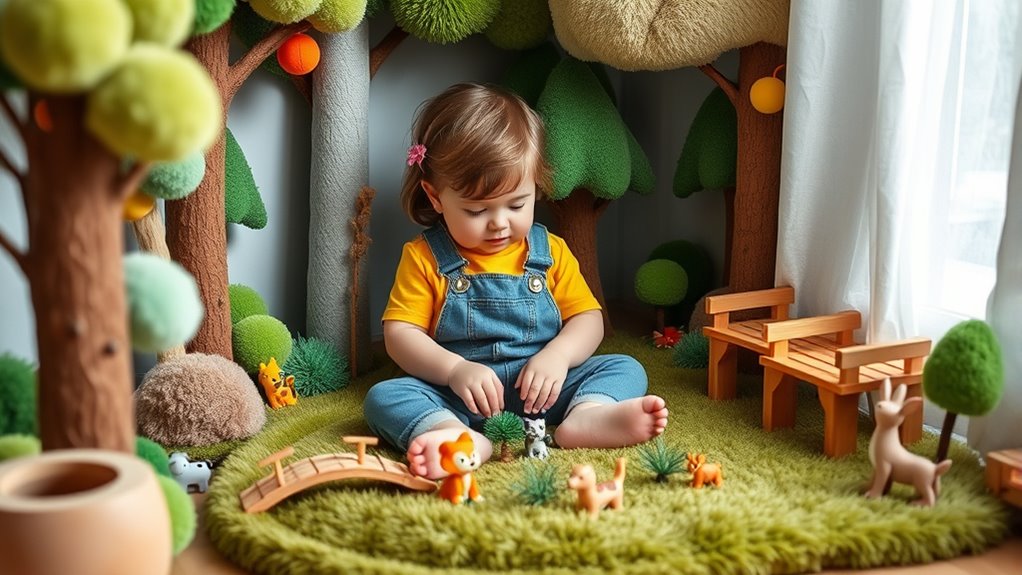
Creating themed play zones transforms your toddler’s environment into a domain of endless imaginative adventures. By setting up areas dedicated to pretend play and role playing, you encourage your child to explore different scenarios independently. For example, a mini kitchen or doctor’s office invites them to imitate real-life activities, fostering creativity and problem-solving skills. Use simple props and costumes to enhance their experience, making each zone a special world of its own. These themed spaces not only promote solo play but also help your toddler develop social and emotional understanding through imaginative role playing. Keep the zones flexible and clutter-free, allowing your child to feel free to invent stories and scenarios without restrictions. This approach nurtures independence and sparks their natural curiosity.
Quiet Time Activities for Calm Play
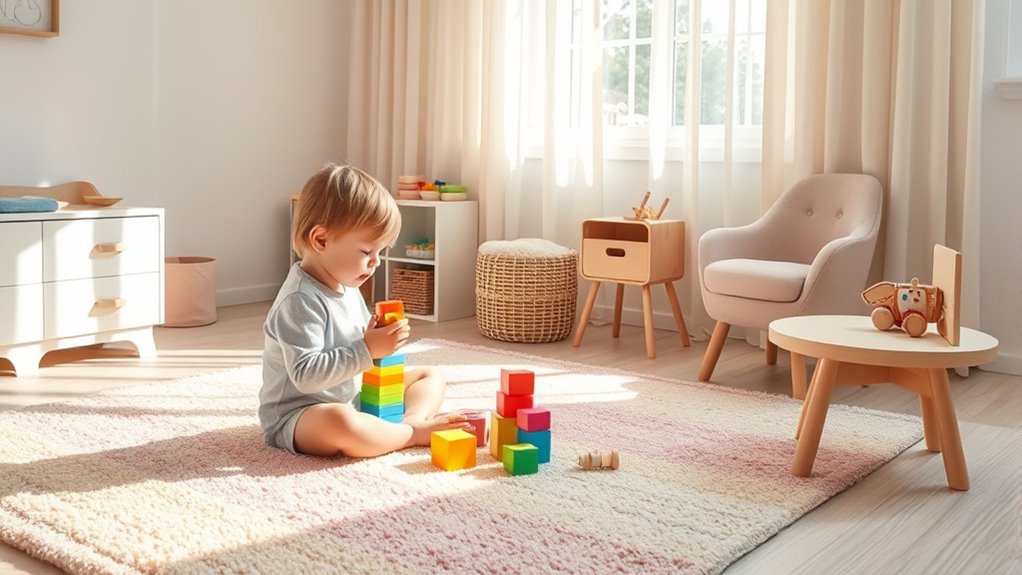
Quiet time activities give your toddler a peaceful way to unwind and develop focus. Incorporate simple calming techniques like mindful breathing and calming music to help your child relax. Create a cozy corner with soft cushions and gentle melodies to encourage calm play. Activities like looking at picture books, stacking blocks quietly, or listening to soothing sounds promote mindfulness and self-regulation. Here’s a quick look at some ideas:
| Activity | Description |
|---|---|
| Mindful breathing | Guide your toddler to take slow, deep breaths to stay centered. |
| Listening to calming music | Play gentle tunes to create a peaceful atmosphere. |
| Quiet coloring | Use crayons or colored pencils for relaxed, solo art. |
These activities foster calmness and help your toddler develop self-awareness during quiet time.
Frequently Asked Questions
How Can I Encourage My Toddler to Play Independently?
To encourage your toddler to play independently, start by setting boundaries that foster safe exploration. Offer simple, open-ended toys to encourage creativity and allow them to make choices. Gradually increase alone time, praising their efforts. Stay nearby initially, so they feel secure, then slowly back off. Consistency helps, and celebrating their independence builds confidence. Remember, patience is key as they learn to enjoy solo play.
What Safety Considerations Are Essential for Independent Play Areas?
When setting up safe play zones for your toddler, prioritize supervision requirements to prevent accidents. Make certain the area is free of sharp objects, choking hazards, and small items they could swallow. Use soft flooring or mats for cushioning. Keep an eye on your child at all times, and regularly check the space for new hazards. Creating a secure environment encourages confident, independent play while giving you peace of mind.
How Long Should Independent Play Sessions Last?
You might think endless independent play is ideal, but honestly, your toddler’s attention span is much shorter. Typically, play duration for toddlers should be around 5 to 15 minutes, gradually increasing as they grow. Watching their cues helps you know when to pause or switch activities, ensuring they stay engaged and happy. Remember, quality over quantity, and short, focused sessions often work best for little ones.
How Do I Handle Tantrums During Solo Playtime?
When your toddler throws a tantrum during solo play, stay calm and focus on emotional regulation. Gently acknowledge their feelings and offer reassurance. Use distraction techniques like changing the activity or offering a comforting object to help redirect their attention. Consistently setting boundaries and giving them time to calm down encourages better emotional control over time, making solo play more enjoyable for both of you.
What Are Some Age-Appropriate Toys for Independent Play?
When choosing toys for your toddler’s independent play, focus on age-appropriate options like sensory bins and open-ended toys. Sensory bins stimulate exploration and fine motor skills, while open-ended toys, such as building blocks or clay, encourage creativity and problem-solving. These toys keep your child engaged, support development, and are safe for their age. Always supervise playtime to guarantee safety and maximize learning opportunities.
Conclusion
As you set up each cozy corner and vibrant play zone, imagine your toddler immersed in a world of discovery—colors blending, blocks stacking high, and sensory bins inviting curious hands. These simple, inviting spaces nurture independence and spark imagination, turning playtime into a journey of exploration. With your thoughtful touch, you’ll watch your little one develop confidence and creativity, all while enjoying the quiet joy of solo adventures in a safe, stimulating environment.

